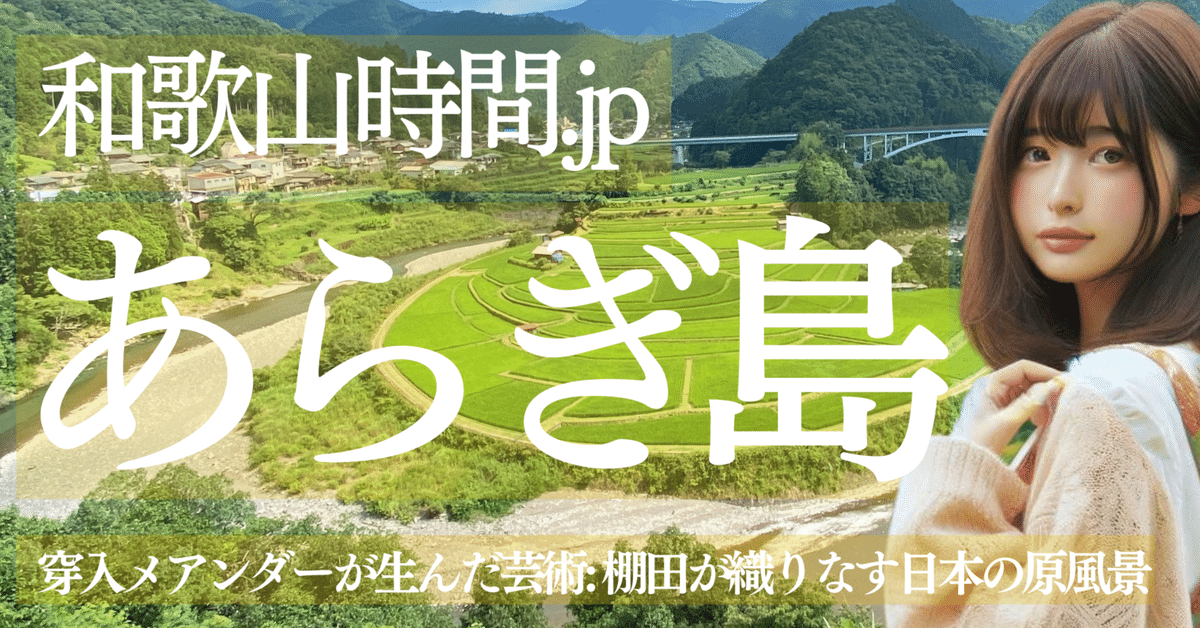
【和歌山時間.jp】第1回 穿入メアンダー(穿入蛇行)が生んだ芸術: 棚田が織りなす日本の原風景
あらぎ島(あらぎじま)は、和歌山県有田郡有田川町清水にある、日本の守るべき原風景のひとつです。この地は、本来「嶋新田」と称されるものの、「あらぎ島」という通称で広く知られており、その名は有田川町の公式ウェブサイトでも用いられています。この地が持つ歴史的、文化的価値は、農林水産省の『日本の棚田百選』、地球環境関西フォーラムの『関西自然に親しむ風景100選』、和歌山県観光連盟の『和歌山県朝日夕陽百選』に選定されることで、国内外に認められています。このように多方面からの評価を受けるあらぎ島は、その美しい景観で知られ、訪れる者に深い印象を残します。


あらぎ島の特徴は、その地形と景観にあります。有田川沿岸のこの地域は、川がΩ字型に曲がりくねる典型的な穿入メアンダー(穿入蛇行)地形を形成しており、その内側に舌状の台地があります。この台地上には、大小54枚の水田が階段状に配置されており、全体で約24,182平方メートル(7,315坪)の面積を占めます。この積み重なるように配置された棚田は、農業技術だけでなく、人々の努力と自然の造形美が織りなすアートワークのようです。特に、対岸から見下ろす景観は圧巻で、かつては清水町の観光案内パンフレットの表紙を飾るほどでした。日本の農村地帯の中でも有数の景観として認められ、その美しさは「第4回美しい日本のむら景観コンテスト」で農林水産大臣賞を受賞するに至りました。

あらぎ島の棚田では、一番上段にある田んぼ、通称「天井田」で収穫された米や餅米を使用してつくられた餅が、秋篠宮夫妻や悠仁親王に献上されています。これは、秋篠宮妃紀子の父方の曽祖父がこの地出身であるという繋がりから来ており、毎年9月6日の悠仁親王の誕生日を祝うための棚田をろうそくでライトアップするイベントが行われています。このような行事は、あらぎ島の棚田が単なる農業地帯を超え、地域の文化や伝統を象徴する場所であることを示しています。

あらぎ島の棚田が今日に至るまで美しい景観を保ち続けられているのは、地域住民や関係者の長年にわたる保全活動のおかげです。江戸時代の初期、1655年には地元の庄屋であった笠松左太夫の資金提供と指導のもと、約3km南にある湯子川から水を引く灌漑水路(上湯用水)の工事が開始されました。これにより、水田の開墾が進み、農業が栄える基盤が築かれました。1996年には「あらぎ島景観保存会」が設立され、景観保全や耕作・維持の負担軽減を目的とした活動が積極的に行われています。こうした努力の結果、あらぎ島の棚田は2013年10月に「蘭島及び三田・清水の農山村景観」として国の重要文化的景観に選定されました。

あらぎ島の棚田は、その絶景で知られているだけではありません。これらの棚田は、長い年月をかけて地域の人々によって手入れされ、維持されてきた生きた文化遺産であり、単なる農業の手段を超えた、地域社会の結びつき、伝統、文化の象徴です。各畝が語る物語は、地域共同体の精神と、世代を超えて受け継がれてきた知恵と技術の証です。

この地を訪れるとき、私たちはただその場の美しさに圧倒されるだけではなく、その背後にある数え切れない努力と地域社会の強い絆を感じ取ることができます。あらぎ島の棚田を歩くことは、日本の農村部が直面している数々の挑戦と、その挑戦にどのように立ち向かい、乗り越えてきたかを理解するための旅でもあります。春夏秋冬、四季折々の風景が織りなす美しさは、自然との調和の中で生きることの大切さを教えてくれます。また、地球温暖化や環境破壊といった現代が直面する課題への意識も高めてくれます。

さらに、この地では、地元産の食材を活かした料理や、地域固有の祭りなどを通じて、地元文化に深く触れることができます。これらの体験を通じて、訪問者は地域の人々と直接交流し、彼らの日常生活や価値観について深く学ぶことが可能になります。このような交流は、あらぎ島の棚田が単なる観光地以上のもの、つまり教育的で感動的な体験を提供する場所であることを示しています。

この地の豊かな歴史と文化的価値を深く理解することで、私たちは自然環境を守ることの重要性と、持続可能な生活様式への移行がいかに重要であるかを改めて認識することになるのです。あらぎ島の棚田を訪れる体験は、単に記憶に残る風景を提供するだけでなく、私たちの心に深く刻まれる教訓となり、自然との調和の中で生きるための新たな視点を開くことになるのではないかと思います。ぜひ訪れてほしい日本の原風景の一つです。
Aragijima is one of Japan's landscapes that must be preserved, located in Shimizu, Aridagawa Town, Arida District, Wakayama Prefecture. Originally referred to as "Shimada," it is widely known by the nickname "Aragijima," a name also used on the official website of Aridagawa Town. The historical and cultural value of this area is recognized both domestically and internationally, as evidenced by its selection for the Ministry of Agriculture, Forestry and Fisheries' "Top 100 Terraced Rice Fields of Japan," the Kansai Global Environment Forum's "Top 100 Kansai Landscapes to Experience Nature," and the Wakayama Prefectural Tourism Federation's "Top 100 Wakayama Prefecture Sunrises and Sunsets." Aragijima receives accolades from various quarters for its beautiful scenery, leaving a profound impression on visitors.
Aragijima's uniqueness lies in its topography and landscape. The area along the Arida River forms a typical entrenched meander, creating a tongue-shaped plateau within its bends. This plateau hosts 54 terraced paddies of varying sizes, covering an area of approximately 24,182 square meters (7,315 tsubo). These stacked terraces represent not only agricultural technology but also a work of art woven from human effort and natural beauty. Especially, the view from the opposite bank is breathtaking, once gracing the cover of Shimizu Town's tourist brochures. Recognized as one of Japan's premier rural landscapes, its beauty earned the Minister of Agriculture, Forestry and Fisheries Award at the 4th Beautiful Japan Rural Landscape Contest.
The rice and mochi rice harvested from the topmost paddies, known as "ceiling paddies" on Aragijima, are presented to Prince Akishino, his wife, and Prince Hisahito, stemming from the connection that Princess Kiko's great-grandfather hailed from this area. An event lighting up the terraced fields with candles is held annually on September 6th to celebrate Prince Hisahito's birthday, illustrating that Aragijima's terraces transcend mere agricultural zones, symbolizing regional culture and traditions.
The preservation of Aragijima's scenic beauty to this day is thanks to the conservation efforts of local residents and stakeholders. In the early Edo period, around 1655, a local headman, Kasamatsu Sadau, initiated and funded the construction of an irrigation canal (Kamiyuyosui) from Yukikawa River, about 3km to the south. This facilitated the cultivation of rice fields and laid the foundation for prosperous agriculture. In 1996, the "Aragijima Landscape Preservation Association" was established, aiming for conservation of the landscape and reduction of cultivation and maintenance burdens. As a result of these efforts, Aragijima's terraced fields were designated as part of the "Important Cultural Landscape of Ranjima and Mita-Shimizu" by the government in October 2013.
More than just a picturesque site, the terraced fields of Aragijima are a living cultural heritage, meticulously maintained over many years by the local community, symbolizing the ties, traditions, and culture of the area beyond mere agricultural practices. The stories each ridge tells are testament to the communal spirit and the wisdom and techniques passed down through generations.
Visiting this site, one is not only overwhelmed by its beauty but can also sense the countless efforts and strong community bonds behind it. Walking through Aragijima's terraced fields is a journey to understand the challenges faced by Japan's rural areas and how they confront and overcome these challenges. The beauty created by the changing seasons teaches the importance of living in harmony with nature and raises awareness of contemporary issues such as global warming and environmental destruction.
Furthermore, through local cuisine and unique festivals, visitors can deeply engage with the local culture. These interactions allow visitors to learn deeply about the daily lives and values of the local people, making Aragijima's terraced fields more than a tourist destination; they provide an educational and moving experience. Understanding the rich history and cultural value of this site reinforces the importance of protecting the natural environment and the critical need to shift towards sustainable living practices. Visiting Aragijima's terraced fields offers not just memorable landscapes but lessons that deeply engrave in our hearts, opening new perspectives on living in harmony with nature. It is indeed one of Japan's original landscapes that is highly recommended for a visit.
この記事が気に入ったらサポートをしてみませんか?
